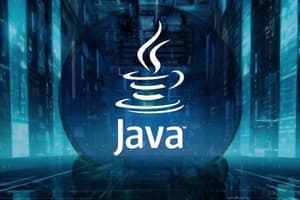Podcast
Questions and Answers
What is the purpose of encapsulation in object-oriented databases, and how is it relaxed in database applications?
What is the purpose of encapsulation in object-oriented databases, and how is it relaxed in database applications?
Encapsulation is the concept of hiding the internal implementation details of an object from external users. In database applications, this requirement is relaxed by dividing object structures into visible and hidden attributes, where visible attributes can be accessed directly through query languages and hidden attributes can only be accessed through predefined operations.
What is the difference between the interface and implementation of an operation in object-oriented databases?
What is the difference between the interface and implementation of an operation in object-oriented databases?
The interface of an operation, also known as the signature, defines the name and arguments of the operation, while the implementation, also known as the method, defines how the operation is carried out.
What is the purpose of a class in object-oriented databases, and how is it related to type definitions and operations?
What is the purpose of a class in object-oriented databases, and how is it related to type definitions and operations?
A class is a type definition that includes the definitions of operations that can be applied to objects of that type. It defines the structure and behavior of an object, including the operations that can be performed on it.
How are operations invoked on objects in object-oriented databases, and what is the purpose of the dot notation?
How are operations invoked on objects in object-oriented databases, and what is the purpose of the dot notation?
What is the purpose of the constructor operation in object-oriented databases, and how does it differ from the destructor operation?
What is the purpose of the constructor operation in object-oriented databases, and how does it differ from the destructor operation?
Any ______ object that is added to the set of ALL_DEPARTMENTS by using the add_dept operation becomes persistent by virtue of its being reachable from ALL_DEPARTMENTS.
Any ______ object that is added to the set of ALL_DEPARTMENTS by using the add_dept operation becomes persistent by virtue of its being reachable from ALL_DEPARTMENTS.
The ODMG ODL standard gives the schema designer the option of naming an ______ as part of class definition.
The ODMG ODL standard gives the schema designer the option of naming an ______ as part of class definition.
In traditional database models, such as the relational model, all objects are assumed to be ______.
In traditional database models, such as the relational model, all objects are assumed to be ______.
A class declaration of EMPLOYEE specifies only the type and operations for a class of objects and the user must separately define a persistent object of type ______(EMPLOYEE) or ______(EMPLOYEE) whose value is the collection of references (OIDs) to all persistent EMPLOYEE objects.
A class declaration of EMPLOYEE specifies only the type and operations for a class of objects and the user must separately define a persistent object of type ______(EMPLOYEE) or ______(EMPLOYEE) whose value is the collection of references (OIDs) to all persistent EMPLOYEE objects.
It is possible to define several persistent ______ for the same class definition, if desired.
It is possible to define several persistent ______ for the same class definition, if desired.
Flashcards are hidden until you start studying




